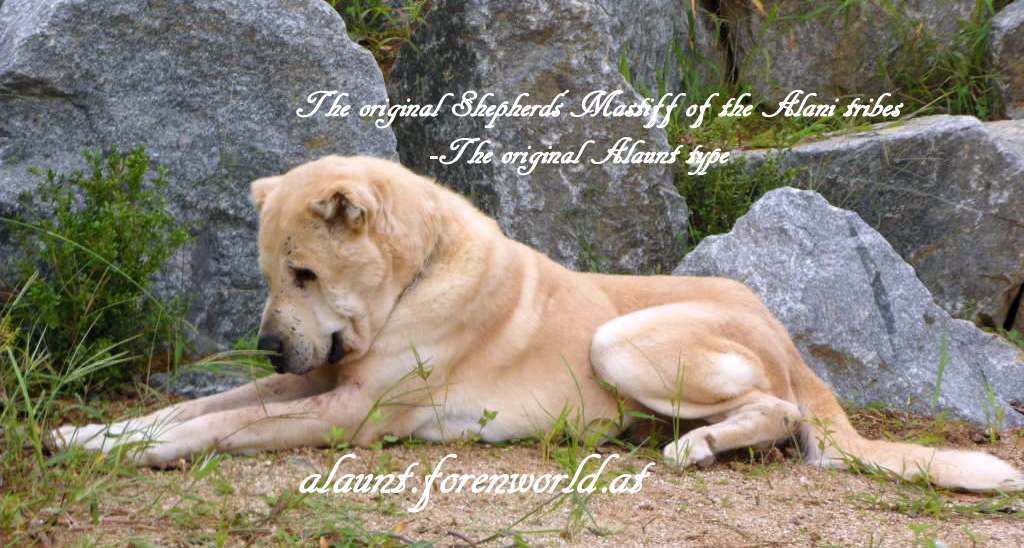-
Yes! It is Andreas, SunnyAK.
Yes, it´s me and thank you for your invitation and nice welcome! I will now use bold letters for my own words & thoughts and normal letters or cursive script for quoted parts. So the bold letters don´t mean I consider my own words as more important, It is just to make it easier. I still don´t know how to quote correctly here, it works differently than on other boards.
I think both terms Molosser and Alaunt are overused. With that said and this is no criticism concerning the name of you board Gary! It is the same with my board. It´s name is “alaunt.forenworld.at” but still not all breeds we discuss are Alaunt types. However I would disagree about the first statement made in the profile here “The legendary Alaunt is one of the most important Molosser breeds” because concerning its origin the Alaunt is neither a Molosser, nor is “the Alaunt” a breed, but a type.
Let´s have a look at LGDs. Not all LGDs are Molossers! Some for sure are Molossers, while others for sure are Alaunts.
I go by origin when I use the word Molosser or Alaunt, however there are for sure crosses between all kinds of dogs. Today every bigger dog is called a Molosser and this I consider to be nonsense. No matter if Dobermann or Tosa Inu etc. they are all incorrectly called Molossers. Then there are authors like Hancock who have tried to be more precise, but in my opinion contradict themselves:
Just have a look here:
http://alaunt.forenworld.at/viewtopic.php?f=9&p=288&sid=052998951aae4129360d8b38b920fb34#p288
Hancock for example makes a lot of strange & wrong conclusions, after first stating some correct things, He seems to be focused on continuing the Victorian era stuff.
Here his words.....
Hanthingy about Mastiffs:
"They were the seizing dogs, the big game hunters; guarding sheep was not their forte, eating them was much more their style! As Betteloni wrote in 1800: '...mastiffs from Tartary, molossians from Epirus, hounds from Flanders..."
He simply shall look where Tartary was located (the whole area) and what kind of Mastiffs the nomadic people who lived there used. They had Shepherds´ Mastiffs that protected their flocks! So how can he on one side correctly state "Mastiffs from Tartary" and then incorrectly state "guarding sheep was not their forte, eating them was much more their style." while they used them to guard their flocks?"Tartary (Latin: Tartaria) or Great Tartary (Latin: Tartaria Magna) was a name used by Europeans from the Middle Ages until the twentieth century to designate the Great Steppe, that is the great tract of northern and central Asia stretching from the Caspian Sea and the Ural Mountains to the Pacific Ocean inhabited mostly by Turkic, Mongol peoples and also by some Cossacks of Russian origin, citizens of the Mongol Empire who were generically referred to as "Tartars", i.e. Tatars. It incorporated the current areas of Pontic-Caspian steppe, Volga-Urals, Caucasus, Siberia, Turkestan, Mongolia, and Manchuria."
He also states that catch dogs are no Molossers, but somewhere else calls the Great Dane a Molosser. Again strange! The Great Dane/Deutsche Dogge was used to catch wild boars, so it was the typical catch dog by function. Maybe a bit more "killing orientated" than some catch dogs with less hound blood, but still a catch dog.
From the Molosserdogs profile:
"In reality, the original Alaunt looked much more like a Central Asian Ovcharka or the Armenian Gampr than the Alano Espanol or the Great Dane. A number of modern breeds are considered to be either the same thing or the direct descendants of the Alan Dogge, but in order to understand the true origin of this great dog, we need to trace it back to the its Caucasian and Central Asian roots and the people responsible for its creation and introduction to the western world."
Here I absolutely agree with your profile and it can be said it is a documented fact, as the Alani settled in Caucasus and came from the area that now is know as Iran. You can find one type of dog everywhere the Alani tribes settled and later in Europe they were crossbred with other types at most places. With that said I also totally agree that the Alano is much less and Alaunt than for example a North Caucasian Volkodav or Tushetian Nagazi aka Georgian Mountain Dog is an Alaunt. The Alano Espanol obviously was bred with dogs of “Beisser type”, very similar in type and function to the original German Boxer!
Here some “pure” original alaunt-types:
Watch this puppy of typical alaunt-type. A bit like a pit bull terrier only 4 times larger in size when fully grown. I like him a lot! Especially the edged and blocky head.

Original alaunt-types that are still around:

And here an alaunt-type Flock Guardian (aka Shepherd´s Mastiff) from Caucasus

But also in Europe dogs of the ancient Alaunt type, we could call them true Alaunt breeds remained. Dogs like the Cão de Gado Transmontano aka Portuguese Mastiff also has a very similar phenotype, while originally being used as both, big game hunter and flock guardian.

About the other Alaunt types, the sighthound types etc. I will write next time, however I agree there anyway with what the breed profile says. The BK I consider to be an Alaunt Veantre in type, influenced by Sighthounds, Bull&Terr crosses and ancient LGD-types, but in type more leaning towards a big game hunter.
P.S. I would say the more Celtic influence, the more the dogs were used for hunting & catching compared to pure Alaunts, that´s why I consider the Alano Espanol more to be a butcher/catch dog type, than a real Alaunt type.
Comment to 'Alaunt or Molosser-The Alaunt: A type, not a breed'
